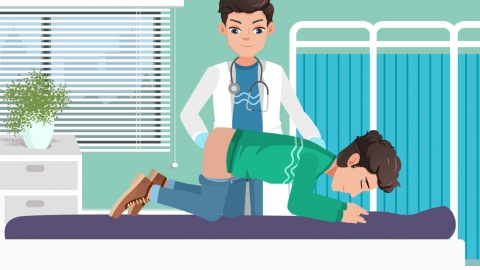How to check for hemorrhoids
Examination for hemorrhoids is generally conducted through methods such as visual inspection of the anus, digital rectal examination, anoscopy, symptom inquiry, and anorectal ultrasound. The details are as follows:

1. Visual Inspection of the Anus: The doctor will ask the patient to assume a knee-chest or lateral position to observe the skin around the anus, checking for external hemorrhoid protrusions, perianal redness and swelling, discharge, or blood stains. The shape of the anal opening will also be examined to preliminarily determine the presence of external or mixed hemorrhoids.
2. Digital Rectal Examination: Wearing sterile gloves and applying lubricant, the doctor gently inserts a finger into the patient's anus to palpate the lower rectum and surrounding tissues, feeling for hemorrhoidal masses, nodules, or tenderness. This helps determine the location, size, and consistency of internal hemorrhoids and rule out other conditions such as perianal abscesses or rectal polyps.
3. Anoscopy: A proctoscope is slowly inserted into the anus, allowing direct visualization of the lower rectum and anal canal. This enables clear observation of the number and location of internal hemorrhoids, whether the mucosa is congested or damaged, and the presence of bleeding points. This assessment clarifies the severity of internal hemorrhoids and provides essential information for developing a treatment plan.
4. Symptom Inquiry: The doctor will carefully inquire about the patient’s symptoms, including frequency and color of rectal bleeding, pain or heaviness during defecation, whether hemorrhoidal tissue prolapses and if it can be reduced, and bowel habits. These symptom characteristics help in determining the type and stage of hemorrhoids.
5. Anorectal Ultrasound: If complications with other perianal diseases are suspected or a more precise evaluation of blood supply to the hemorrhoidal tissue is needed, anorectal ultrasound may be performed. This imaging technique clearly displays the anatomical structures around the anus, defining the extent of hemorrhoids and identifying any additional abnormalities, thereby improving diagnostic accuracy.
When symptoms suggestive of hemorrhoids appear, patients should promptly visit the proctology department at a qualified medical institution, cooperate with the necessary examinations, follow medical advice for treatment and care, and attend regular follow-up visits to prevent worsening or delayed management of the condition.





